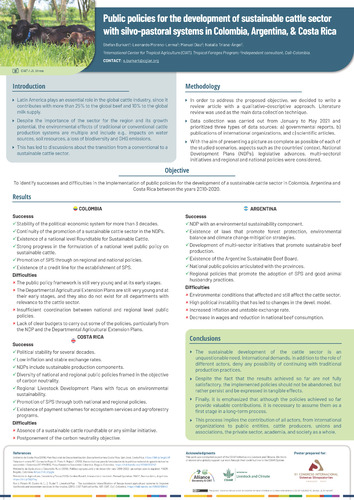Public policies for the development of sustainable cattle sector with silvo-pastoral systems in Colombia, Argentina, and Costa Rica
By contributing more than 25% and 10% to the global beef and milk supply, Latin America and the Caribbean plays an important role in the global cattle industry. The cattle sector generates internal and external benefits as it guarantees food security and strongly contributes to economic development. Cattle production in the region not only has a long tradition but also is foreseen a promising future. By 2050, global meat consumption will increase by 100%, favoring the Latin American cattle industry due to its geographic location and availability of both human and natural resources. Despite this positive panorama, traditional cattle systems are still predominant in the region and can cause multiple environmental impacts, such as on water and soil resources, the loss of biodiversity, greenhouse gas (GHG) emissions, and deforestation. The political debate thus centers around the transition from traditional to sustainable cattle systems, in which natural resources are being conserved and social and economic benefits increased. Despite the existence of numerous sustainable production alternatives, such as silvo-pastoral systems (SPS), adoption levels are low and the shift towards sustainability is perceived as slow and uncoordinated.
This study aims to identify achievements and difficulties in the implementation of public policies for a sustainable cattle sector in Colombia, Argentina, and Costa Rica, for which policies focused on the use of silvo-pastoral systems and forage-based solutions were prioritized. These countries were selected considering their contrasting socio-economic realities and the strong efforts they have already made toward the transition to a sustainable cattle sector, evidencing the ongoing political debate and goodwill toward meeting the targets established in the Paris Agreement and the Sustainable Development Goals (SDGs) 2015–2030. Based on the review of scientific articles, legal documents, and publications of public institutions and NGOs, a comparative qualitative analysis was carried out, documenting key policy developments between 2010 and 2020.
The results indicate that the three countries have a willingness of state institutions to promote a sustainable cattle sector, expressed by their national development plans and legislative advances. The strategies of the three countries are similar, focusing on the need to reverse the loss of natural resources, reduce GHG emissions, stop deforestation, and promote the use of SPS. Although these documents usually contain general statements regarding the problems, often without being reflected in tangible results, it is necessary to recognize that they have also been the starting point for large-scale initiatives. The carbon-neutrality objective of Costa Rica stands out, a commitment that has made the country an international benchmark. The national, regional, and multi-actor strategies that exist in the three countries are another expression of this political will. The capacity for articulation among the actors is fundamental, linking public, private, academic, and other institutions, since it responds to the concept of public policy in which decisions are the result of joint work. In that regard, the sustainable cattle roundtables of Colombia and Argentina have had a preponderant role. Regarding the continuity and association of the programs, disparate circumstances are evident. In the case of Costa Rica, the carbon-neutrality objective has been preserved in the different governments and national development plans as well as in multi-sector and regional initiatives, such as the Cattle NAMA. In Argentina, although without a purpose as defined as in Costa Rica, national policies are well articulated with those at the local level, i.e., regarding silvo-pastoral systems. The situation in Colombia has not been as favorable since for many years no public policy coordinated local sustainability efforts, and thus their development has been independent and in a disorderly manner. The results suggest the sustainable development of cattle farming as an unquestionable necessity for the region since international demand and the role of different actors limit the possibility of continuing with traditional production practices. This scenario prompts the national governments to take forceful actions, which is not always reflected in the same way, since each country has particularities that determine the processes and, therefore, the results. Colombia, Argentina, and Costa Rica demonstrate such contrasts but despite there are dissimilar advances, the realities are not completely opposite to each other. On the contrary, the general perception is similar insofar as they are all in a process of evolution and still have many objectives to be achieved within the framework of the Paris Agreement and the SDGs.
Even though the results are not fully satisfactory, the actors should persist so that public policies can lead to tangible effects. It is recommended to develop public policies with clear timelines and budgets that facilitate development, implementation, articulation, and evaluation. At the same time, it is necessary to strengthen extension systems to provide cattle producers with the necessary knowledge for the transition to sustainable production systems. For Argentina, it is recommended that state institutions increase their efforts in deforestation policies, mainly for the Gran Chaco region. Colombia should formulate more ambitious objectives regarding the implementation of SPS. In Costa Rica, it is essential to articulate actions of national and international institutions with a multi-actor platform for sustainable cattle. For the three countries, the consolidation of the use of technological innovations that contribute to the monitoring of deforestation is recommended.

